STEP 2. Day 1. Choose the substrate for mushroom cultivation
At this step, you've already prepared a liquid spore syringe. While it is languishing in a syringe (minimum for 24 hours) and waiting for inoculation, it's time to take care of the substrate for future magic mushrooms.
Before the next manipulations I'd like to explain you briefly some differences between substrates. Usually newbie growers confuse what is what.
Each type of substrate has specific features, different content and it is used on different steps of mushroom cultivation process
This overview will help you to connect the dots. Please, don't skip it!
Types of substrates for magic mushroom growing: grain substrate, bulk and casing
1. Grain substrate for mushroom spawn
Spawn — culture of mycelium on grain substrate
The first substrate for mycelium growing is grain substrate. It is used for the first steps of cultivation process almost for all mushrooms, actives and edibles. In sterile grain substrate spores propagate and create mycelium network.
Grain is a highly nutrient, rich in carbohydrates substrate for rapid mycelium production. Until too much nutrients mycelium continue colonisation phase (mycelium formation) and don't produce mushroom fruits on this step.
For spawn we should use whole grain (in husks) only! The shell of the grain have cellulose (fiber) that protects each kernel against clumping, excess moisture and further bacteria contamination. Also cellulose is a common source of nourishment for cultivated fungi.
What grain we usually use for spawn?
Wheat berries, oats, barley, corn, popcorn, brown rice, rye, wild bird seeds (WBS), millet, sorghum
Fungi love any grain from the list above. Choice is up to you!
Newbie growers also choose substrate based on the brown rice flour (BRF). It is a mix of BRF (1 part), vermiculite (2 parts) and water (1 part). It is recommended substrate recipe for PF-tek growing we discussed later
2. Bulk substrate for mushroom fruiting
Bulk substrate — secondary substrate in mushroom cultivation also called fruiting substrate for producing mushrooms (after spawn to bulk). Bulk substrate is less nutrient than grain substrate. Fruiting substrate is a source of additional water and ingredients for mushroom metabolism and fruit development
Spawn to Bulk — transfer grain spawn to secondary fruiting substrate (bulk) for further bulk colonisation (spawn run) and mushroom fruiting.Such transfer allows you to spread the mycelium (spawn run) for the next step of mushroom cultivation — mushroom fruiting period. Bulk substrate vary and depends on the mushroom genus and species (actives and edibles).
In fact, for Psilocybe Cubensis spawn to bulk is optional, but it can significantly increase your yield. We'll discuss possible options in our guide later
What can be used for fruiting substrates?
coconut coir, hay, straw, grain hulls, manure, compost, sawdust, paper products, wood pellets, wood chips, corncobs, coffee plants and waste, tea leaves, sugarcane bagasse, banana fronds; seed hulls (cottonseed, sunflower, and oil-rich seeds); almond, walnut, pecan, peanut hulls; soybean meal, roughage (okara), and soy waste; artichoke waste; cactus waste: saguaro and prickly pear, yucca, agave
For Psilocybe cubensis and Natalensis coco coir mix is the most popular bulk substrate.
For Panaeolus species is manure based substrate, also hay and straw can be added to the mix.
For Psilocybe azurescens — sawdust, paper products, wood pellets, wood chips.
Other substrates usually used for edibles. For Oysters — hay, straw. For Hericium species aka Lion's Mane — sawdust, bran, seed hulls. For Shiitake — sawdust, wood pellets, wood chips, seed hulls.
3. Casing substrate
Casing — a layer of substrate over bulk substrate
Casing is low nutrient substrate, usually the layer about 1/2 inch (1-1,5 cm). It is additional source of moisture, some kind of stress and sign for mycelium, that "no more nutrients further! Hurry up! Form fruit body, spread spores and save your genus!" And boom! Fruits are coming!
Some species are absolutely dependent upon casing layer (Panaeolus aka Copelandia).
Some aren't and casing is optional (Psilocybe Cubensis, Natalensis) or not required at all.
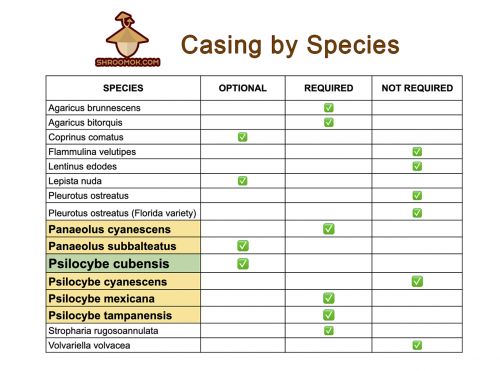
What usually used for casing substrate?
cacti soil, peat moss aka sphagnum and vermiculite
Mix of cacti soil, sphagnum and vermiculite is the best casing layer for Panaeolus.
For Psilocybe Cubensis casing layer can be the same bulk substrate based on coco coir. It is used for making small mushroom cakes, when we skip spawn to bulk and just cover grain spawn with coco coir mix as a casing layer. We'll figure out it on the Step 8. Spawn to Bulk and Casing. How to make mushroom cake
Grain for mushroom spawn
Ready sterilised grain
Now let's start magic mushroom growing with grain substrate preparation for spawn.
You can buy ready sterile grain for mushroom spawn. Then skip the next 3 steps and move on Step 6. Inoculation
It's a great option if you want to try mushroom cultivation with ease, save your time and money for expensive pressure cooker, spawn jars/bags and some additional stuff.
Shroomok's choice on Amazon:
Sterilized Rye Berry Substrate - 1 Bag - $9.69
Sterilized Milo Grain Bag, 3 Lb - 1 Bag 14.95
Sterilized Wheat Grain Bag, 3 Lb - 1 Bag $16.88
Sterilized Rye Grain Jar - 1 Jar $17.99
Sterilized Rye Grain Jar - 2 Jars $29.56
Sterilized Rye Berry Grain Bag, 3 Lb - 2 Bags $38.74
All in One Mushroom Grow Bag, 5 LBS - 1 Bag $42.50
Sterilized Rye Berry Grow Bags, 1 Pound - 6 Bags $46.50
BRF Jars, Brown Rice Flour Mushroom Substrate - 6 Jars $49.99
Sterilized Rye Berry Jars - 1 Qt - 4 Jars $59.95
Choose grain for DIY substrate
Actually Shroomok suggests to handle the whole process by your own. It will be cost effective for long term mushroom cultivation hobby. Moreover you totally control the content of the substrate, process of preparation.
You can use any kind of whole wheat, oats, barley, rye, brown rice, popcorn, corn, wild bird seeds, millet, sorghum.
It can be either expensive organic grain for healthy food or grain for feeding animals in pet stores, grain for sprouting for "cat grass".
🔴 Grain should be whole, organic, unhulled (hull intact), untreated with chemicals! Rolled, hulled, peeled grain is not suitable for substrate
Let's take a look some options!
🌾 Whole wheat berries.
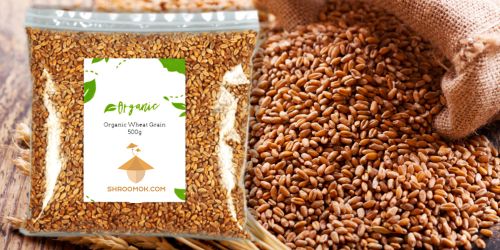
Shroomok's Choice on Amazon:
Hard Red Winter Wheat Berries, 3 lbs - $13.95
🌾 Whole oat grain
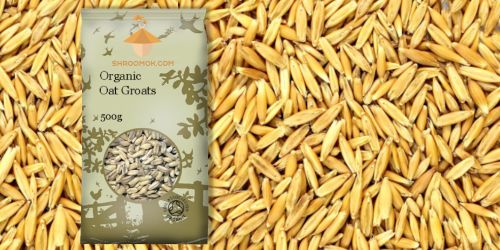
Shroomok's Choice on Amazon:
Organic Whole Oat Grain Seeds (With Husk Intact), 2/5/10 Lb $15.99
🌾 Brown rice

Shroomok's Choice on Amazon:
Brown Rice 5 lb $19.35
Long Grain Brown Rice, 5 lb $19.99
🌾 Millet, WBS, Rye, Sorghum, Barley
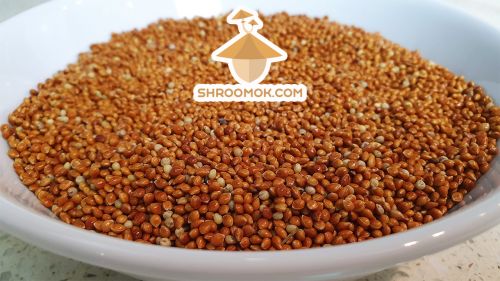
Shroomok's Choice on Amazon:
Wild Bird Seeds Mix, 4.4 lbs $18.64
Whole Grain Sorghum, 24 Ounce $8.79
Millet Grain, 3 lb $13.99 (can be used hulled millet for spawn)
Organic Rye Berries, 5 lbs $21.95
Unhulled Barley (Hull Intact), 12 Lbs $31.99
White Proso Millet, 10 lbs $23.95
Red Proso Millet, 20 lbs $49.79
How much grain is needed for mushroom spawn
With one liquid spore syringe or liquid culture syringe (10 ml) you can inoculate about 5-10 jars/bags with substrate.
Dry grain after soaking and cooking increase the volume by 25-35%.
Each jar/bag usually contain from 12 oz (350 ml) to 34 oz (1 liter) of ready grain substrate. It depends the volume of your jars or bags for substrate. Up to 34 oz (1 liter) is optimal.
Each jar filled up to 2/3 of the volume.
That's why for calculation we are going to talk about volume of grain instead of weight! Usually 34oz = 1 liter = ~800g
Hence you need per one jar/bag:
16 oz (500 ml) jar = about 9-10 oz (250-300 ml) of DRY grain or about 250g of DRY grain
24 oz (700 ml) jar = about 12 oz (350 ml) of DRY grain or about 300g of DRY grain
34 oz (1000 ml) jar/bag = about 17 oz (500 ml) of DRY grain or about 400g of DRY grain
How to prepare jars/bags we'll discuss later on Step 4. DIY Jars & Bags for substrate
But before we need to cook grain for substrate properly!
Let's move on the next step of our guide — STEP 3. Day 2. Cooking the substrate for spawn 🔽


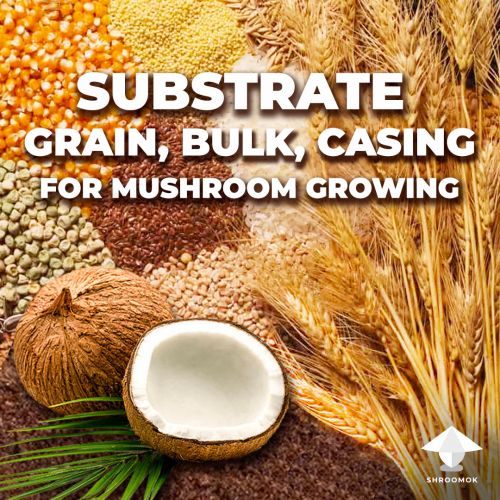
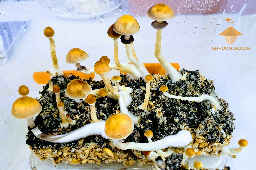
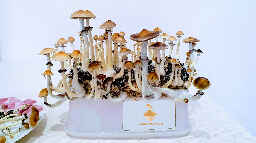
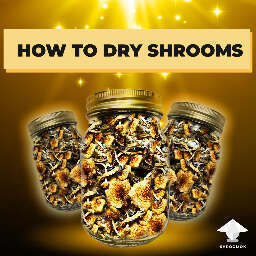
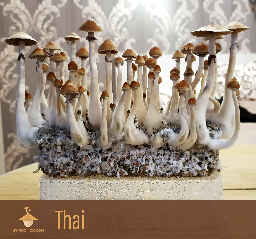
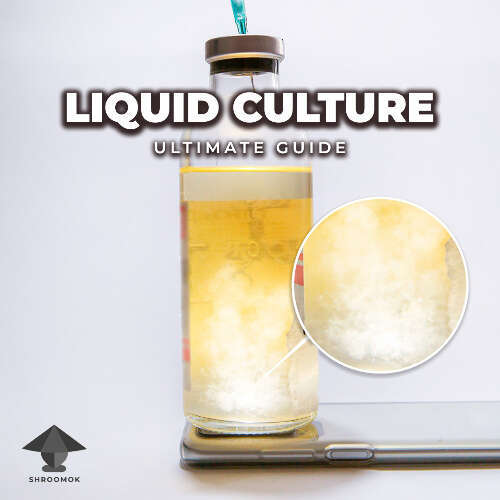
Comments
Have U experimented with mixing substrates?
It's Something i came up with and i would be interested to know if someone has ever done it.
Have U experimented with mixing substrates? I mean like rice and rye together for inoculation.
It's Something i came up with and i would be interested to know if someone has ever done it.
@Albe Yes, you can prepare a mix of grains for your spawn. But note that different types of grains have different cooking time. It is better to cook them separately (should be perfect al dente grain, not too wet and too dry), then mix, fill the jars/bags and send to the PC/autoclave for further sterilization.
Add comment